
Ancestry vs. 23andMe: Which DNA Test Kit is Better for You?
AncestryDNA

23andMe

DNA testing has revolutionized the world of genealogy over the past few years and has now become an essential tool for family history research. There are many excellent genealogy reasons to take a DNA test: confirming your family tree, breaking brick walls, connecting with new cousins, and learning about your ethnic make-up are just a few.

This article will compare the 2 leading DNA testing companies who sell autosomal DNA tests for genealogy purposes: AncestryDNA and 23andMe. 23andMe became the first company to offer direct-to-consumer autosomal DNA testing for ancestral purposes in 2007, and Ancestry began selling tests 5 years later in 2012 in the US. But which is best if you want to test for genealogy purposes? Let’s check them out.
Providing the DNA Sample
Both tests are professionally packaged, easy to use, contain simple to follow instructions and provide helpful return shipping options. The first thing you should do for both companies is activate the kit online at the applicable website. Next you need to provide your sample, and these companies use exactly the same collection method: both tests require a saliva sample so you have to fill a small tube with around a quarter of a teaspoon of saliva to complete the test. Once you have done this, all you need to do is place the completed sample in the provided return shipping box and pop it in the mail. Processing times for both companies vary depending on recent sales, but there is not a great difference in the wait time and you should receive your results with both within 3-6 weeks.
Winner: Draw (almost identical experience)
Database Size
This is one of the most crucial considerations, as the larger the database, the more matches you will receive and the better your chances of being successful in using your DNA results to aid your family tree research. Ancestry has by far the largest database of all of the testing companies with over 15 million testers, while 23andMe has the second largest with over 10 million testers. These are the 2 big powerhouses of the genealogy DNA testing world, but the Ancestry database is simply larger and this cannot be overlooked, especially if you have a mystery to solve.
Winner: AncestryDNA
Ethnicity Estimates
Autosomal DNA tests consist of 2 main features—an ethnicity estimate and a DNA match list. Ethnicity estimates give you an idea of the regions in the world your ancestry stems from and deliver this data in percentages. Ethnicity estimates are the most well-known and advertised aspect of autosomal tests, but it’s actually the DNA match list that is the most valuable for genealogical purposes. It’s important not to take ethnicity estimates too literally (they are called estimates for a reason!) and to be aware that they will differ between companies, as each has its own reference populations and algorithms. Companies also periodically update and refine their estimates so they are prone to change over time as the technology improves and reference sets increase in size. Having said all that, it can be great fun to see your own ethnicity map!
Over 500 global regions make up Ancestry’s ethnicity estimate portfolio. Ancestry has also developed “Genetic Communities” and these are identifiable by a circle with a dotted line within the “DNA Story” area of your test results. Genetic communities are primarily based on the trees of your matches and this is what makes them different from the regular ethnicity estimate portion of the results. The system, for instance, has noticed that I have many matches with ancestors from Ulster, Ireland on their trees and therefore suggests that it’s likely I also have ancestors from Ulster. It even drills down to specific regions of Ulster in the form of Tyrone, Londonderry and Antrim, and South Down and North Louth. I do indeed have ancestors from these areas so this part of the test proves to be very accurate in my personal experience.
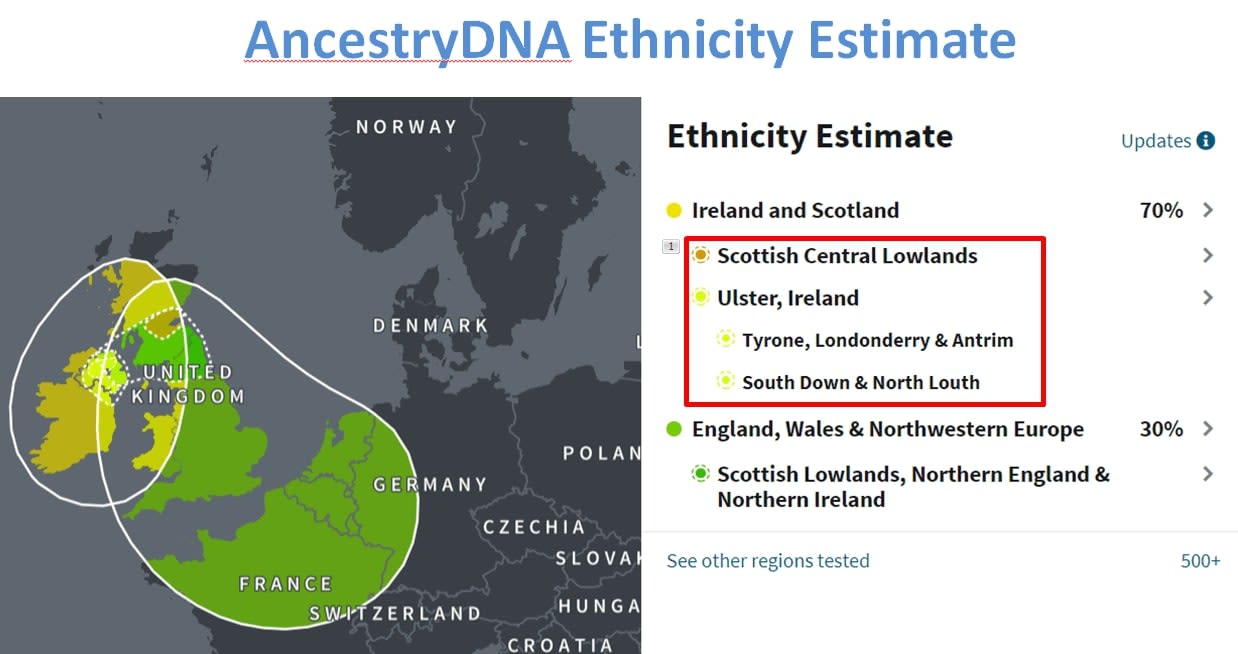
23andMe’s ethnicity estimate is called “Ancestry Composition” and it evaluates a tester’s ancestry based on over 1,500 geographic regions. It also provides a special sub-regional feature called “Recent Ancestor Locations” (RALs). These populate using data provided by your matches on the birth locations of their grandparents which rather limits the scope. I find it sometimes skews toward urban locations since more people have tested from those areas but it certainly can provide some interesting information.
23andMe also offers several other unique features within their Ancestry Composition report. Firstly there’s an “Ancestry Timeline” which predicts when your ancestors may have lived in particular regions. There is also a tool which displays which ethnicities and the percentages thereof you received from which of your parents, so long as you have at least 1 parent tested. The best of their unique features, however, is the “Ancestry Composition Chromosome Painting” which provides a chromosome map that breaks up your DNA segments by ethnicity. This can be very helpful when you have several very distinct ethnicities in your ancestry, but not so helpful if your ancestry is mainly from similar areas.

Both Ancestry and 23andMe regularly update their ethnicity estimates so it’s worth checking back every so often to see if yours has changed in any way.
Winner: AncestryDNA (this is a close call as 23andMe’s offering is excellent, but Ancestry win for Genetic Communities!)
DNA Match Lists
Whichever autosomal DNA testing company you choose to test with, the DNA match list provided is by far the most important feature for genealogy purposes. Essentially this is a list of all other testers in the database who share DNA with you, starting from the closest to the most distant. Match lists provide the name of the match, a relationship prediction or range, and the amount of DNA shared in centiMorgans or as a percentage. The vast majority of your matches will be 3rd or more distant cousins with whom you share a set of common ancestors, and if you can identify those common ancestors you could verify that line on your tree, solve mysteries, break brick walls, add new branches to your tree, and connect with new cousins who share your interest in family history. Finding and connecting with living cousins can be one of the most exciting and rewarding benefits of DNA testing; your new cousins may have family stories and photographs they can share with you that you would never find any other way.
Ancestry’s layout for the DNA match list is very clear and improvements this year mean it’s now possible to organize matches into 24 color-coded groups, as well as filter them in a number of helpful ways. I find the Ancestry match list by far the easiest to organize due to these features and one of my favorite filtering options is being able to filter by the newest high matches—when so many new people are testing every day wading through lots of tiny matches to find the best new ones can be very tedious. The search capabilities are also very useful as you can now search your match list via username, ancestral surname and location. Additionally you can write notes on each match to keep track of your research and these are now visible on the main match list.
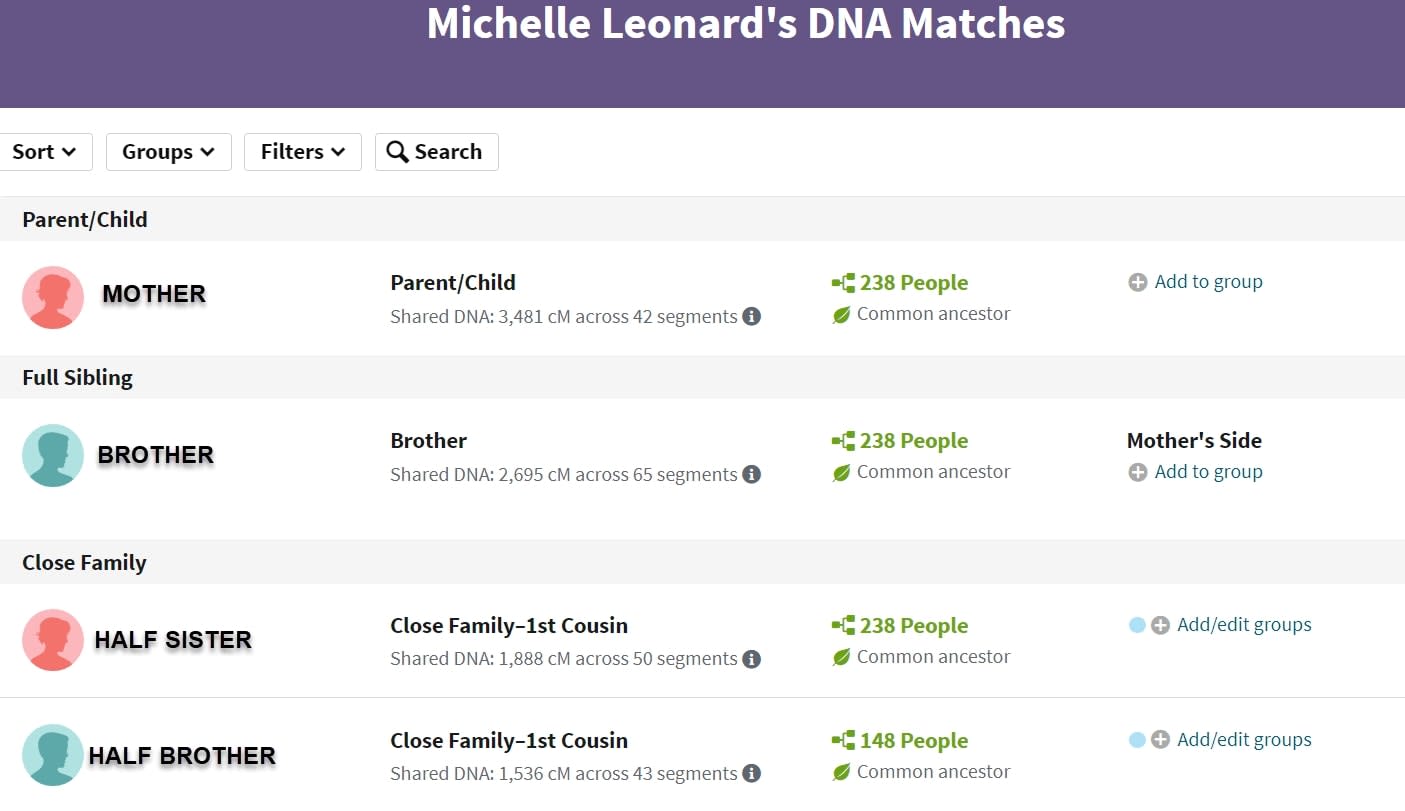
The 23andMe match list is also very well laid out and provides a number of helpful searching and filtering options but does not have the same color-coding organizational capabilities as Ancestry. It is possible to “favorite” matches of interest, but not to organize them into specific groups. There is also a note function, but be aware this is at the foot of the individual match page, and not the main match list.
One key thing you need to understand about the 23andMe match list is that it is limited to your closest 2,000 matches, and this number takes those who have opted out of being shown as a match into account, so the number will generally be lower than 2,000. Another important point is that 23andMe show the amount of DNA you share with a match as a percentage on the main match list as opposed to in centiMorgans (cMs) as Ancestry does. They do include the cM numbers on the individual match page, however, under “View DNA Details.”
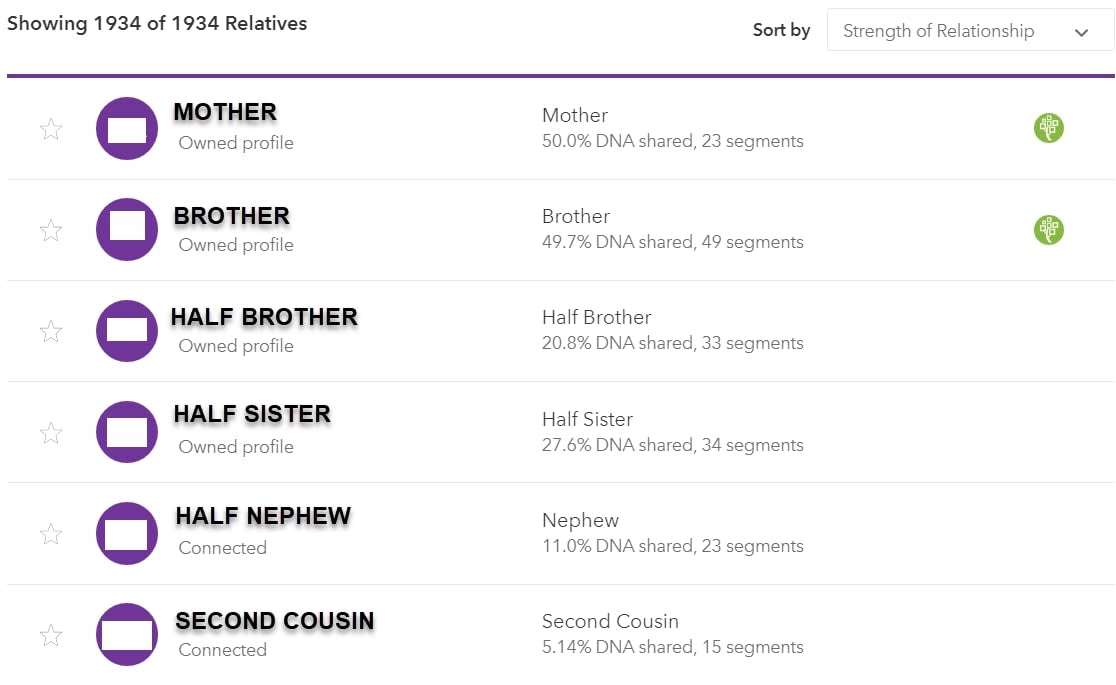
23andMe operates a system through which you can send connection invitations to your matches in order to connect with them and share more information, although be aware if they have chosen to be “open sharing” on the site, you will already have access to all of the information you gain if a match accepts a connection invitation.
The search and filtering capabilities on 23andMe are excellent as you can run a number of searches and filters at the same time and you’re not limited to just 1 or 2. You can search 23andMe lists via match name, ancestral surname, location and even haplogroup. It’s equally possible to sort your matches by the highest new ones as you can on Ancestry. One filtering option 23andMe has that the other companies do not is if you have been able to test only one parent, you can filter by side, e.g. “mother’s side” and “not mother’s side.” This is very useful in that situation.
Winner: AncestryDNA (this is a tight call as both are excellent, but Ancestry has the edge due to the color-coding organizational capabilities)
Shared Matches
Shared matches are very often the key to working out how your matches relate to you so the shared match function provided by the companies is one of the most vital tools they can offer. Ancestry’s shared match list is well laid out and extremely helpful but be aware that it only comprises matches who share over 20cM with you, and it does not list how much DNA the shared matches share with each other—to find that out you would have to be invited to see their list or ask them if they would provide the information personally.
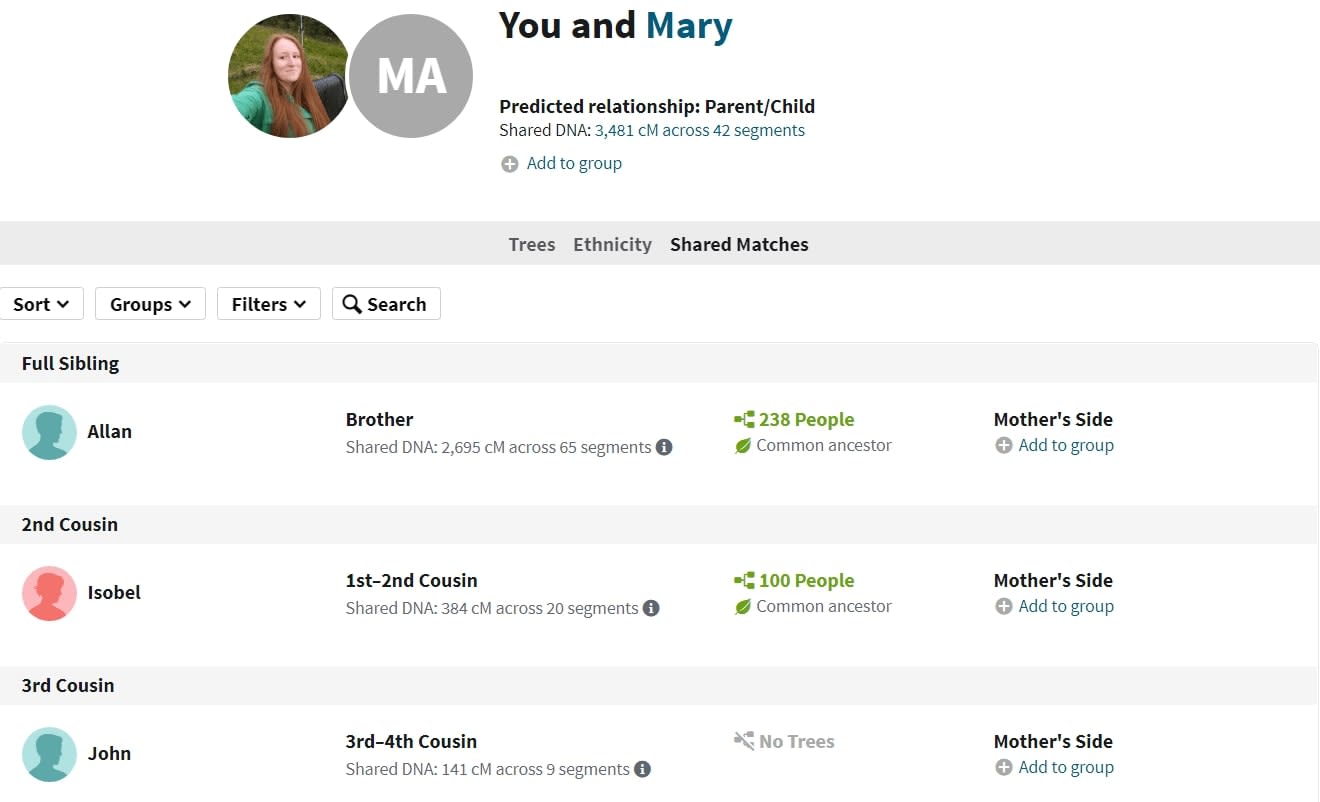
23andMe’s shared match list, called “Relatives In Common,” does not have a limit in the way that Ancestry’s does, so it will show every shared match, including the lower level ones. It also provides full information on how much DNA the shared match shares with both the tester and the match.
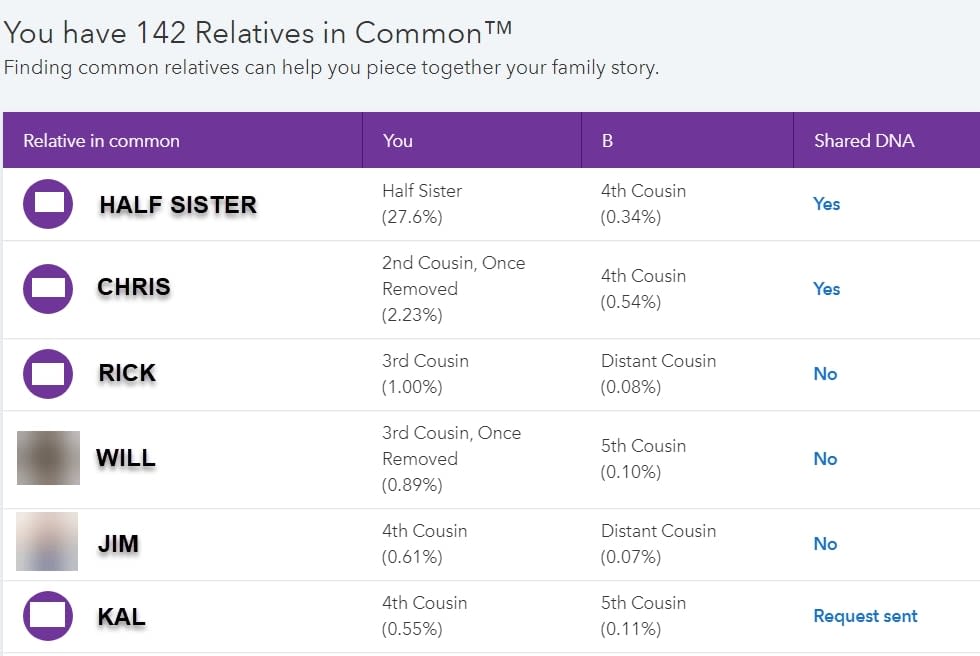
Additionally the “Shared DNA” column is very helpful and is similar to MyHeritage’s triangulated segments—“Yes” means that you share at least one exact segment with both the relative in common and the shared match, and “No” means the 3 of you match each other, but not on any exact segments. If a particular match is not “open sharing” you will not be provided with the “Shared DNA” column information, unless they accept a connection request.
23andMe’s shared match list is a truly excellent tool and one of the most informative shared match offerings across all of the companies alongside that provided by MyHeritage.
Winner: 23andMe
Family Trees & Messaging
Another of the most important features the companies can provide are family trees of matches and a function for you to create your own family tree to share with your matches if you wish. Ancestry is one of the industry leaders when it comes to provision of trees and personal tree-building tools. You can also upload a gedcom if you have created a tree with your own family history software. Whether or not your match creates or attaches a tree to their results is an individual decision however, so how many trees you have to work with will vary depending on your personal matches.
One of the major disappointments with 23andMe over the past few years in terms of genealogy testing has been the lack of any family tree provision on its site. Sharing family tree information is the backbone of working out how you relate to a match, so this is a real problem. It has not been possible to build a tree to share with matches on 23andMe for several years and, therefore, matches haven’t been building trees to share either. It is possible to add a link to a tree you’ve built elsewhere to your profile and to add basic information on your “Family Background” such as the birthplaces of your grandparents and your ancestral surnames, but in practice many people do not fill these in.
In the last few months, however, 23andMe have taken some steps to rectify this situation. Firstly they now allow the linking of FamilySearch trees to their system: not many people have used this facility yet but it’s a step in the right direction. Even more recently they released their own “Family Tree” beta tool. This is an automated tree-building tool which aims to predict your genetic family tree using your matches. It will try to place your matches into a tree and you can add to that tree manually. This is an exciting new tool and a real step forward for 23andMe given their lack of family trees in recent times, but it is still very much in its infancy and only time will tell if it solves the problem of lack of trees on the site.
Another important feature that both sites offer is the ability to contact your matches. Their messaging systems are similar and easy to use.
Winner: Ancestry
Additional Features
Ancestry offers an array of additional features and tools including common ancestor hints, highlighted shared surnames if you and your match have linked trees, predicted relationship probability charts (similar to The Shared cM Project tool at DNA Painter), comparison of ethnicity estimates, a facility to invite others to access and even manage your DNA results, a map showing where your matches are located (if they have given that information on their profile) and mother’s and father’s side filters if you’ve tested your parents.
Ancestry’s newest feature, Thrulines, uses the company’s vast number of family trees to attempt to identify common ancestors between you and your DNA matches.
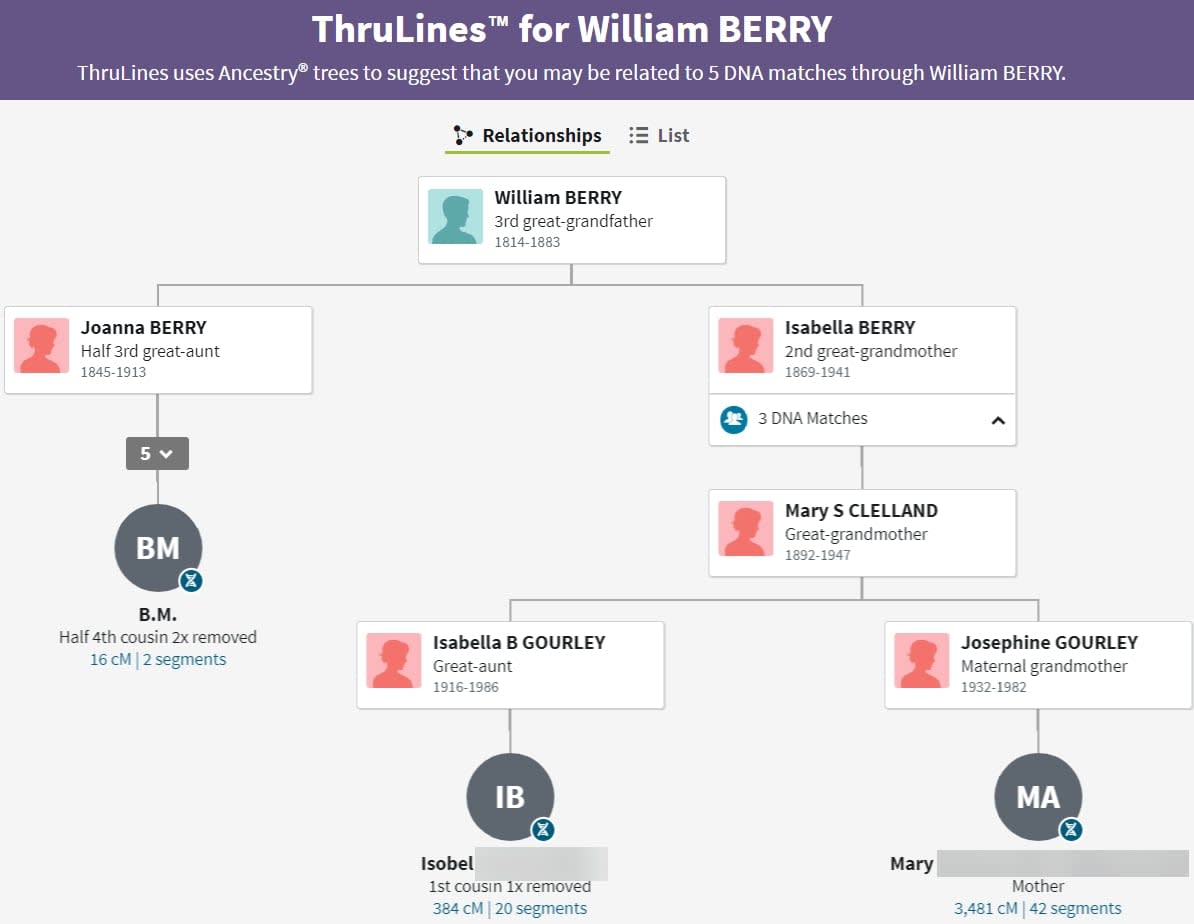
Thrulines can provide you with some excellent clues as to how your matches relate to you, but the key is to always investigate each theory fully before accepting it as fact.
23andMe also has a wide array of additional features, such as comparison of ancestry composition results, and a map showing the location of your matches, but the 2 most important unique additional pieces of information they provide are the Neanderthal Ancestry report and maternal and paternal haplogroups. You will be able to learn how many Neanderthal variants you have inherited and the haplogroups provide information on the ancient origins of your direct paternal and maternal lines (only men will receive the paternal haplogroup as it is based on testing of the Y-Chromosome which women do not inherit). Do not confuse the maternal and paternal haplogroups with the Y-DNA and Mitochondrial DNA tests FamilyTreeDNA sells, as those offer matching databases in addition to haplogroup designations, but the reports and haplogroup information 23andMe provide will certainly give you an interesting glimpse into the origins of your direct paternal and maternal lines.
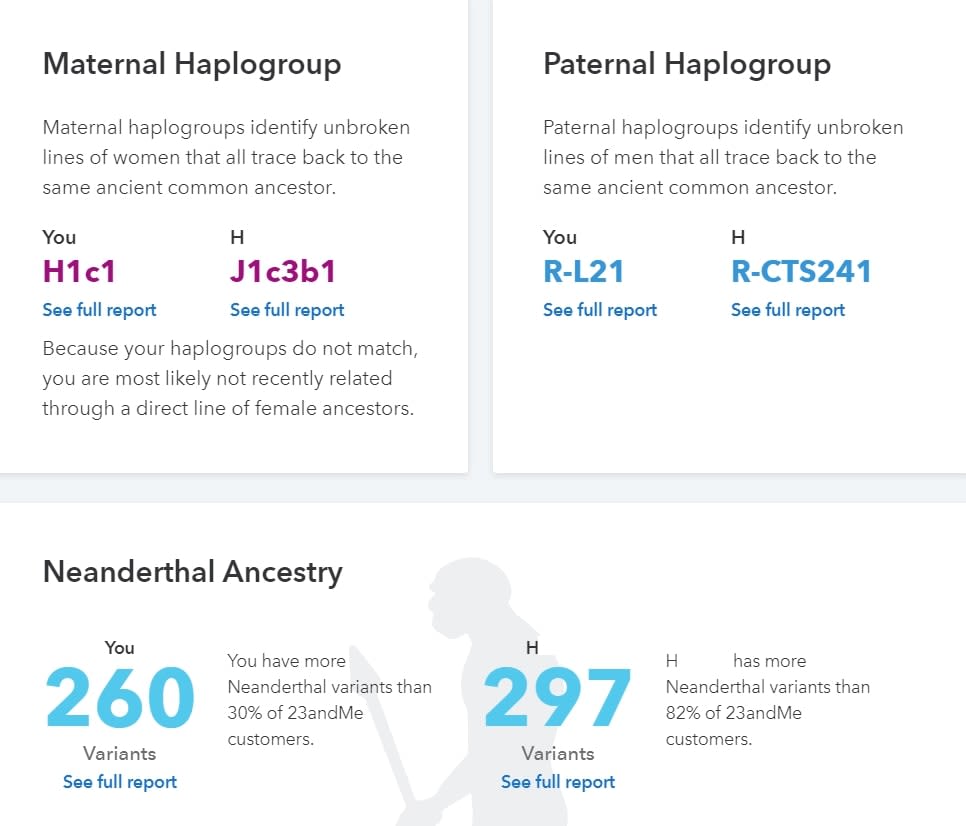
Winner: AncestryDNA (this is close but Ancestry gets the nod for Thrulines)
DNA Tools & Segment Data
23andMe provides detailed DNA segment data and boasts both one-to-one and one-to-many chromosome browsers. A chromosome browser is a visual tool that can be used to compare matches. It allows you to see the exact segments of DNA that matches share in common with you and each other, and on which chromosomes these are located.
On the individual match page under “View DNA details,” a one-to-one comparison between you and your match is displayed. This graphic provides additional details that none of the other browsers on the market do, e.g., whether your match shares completely identical or half identical regions with you. We each have 2 copies of every chromosome (one copy inherited from mom and one inherited from dad) and a match could match you on one copy of both copies: the most common relatives that would match on both copies would be full siblings, since they will also inherit DNA from both parents.
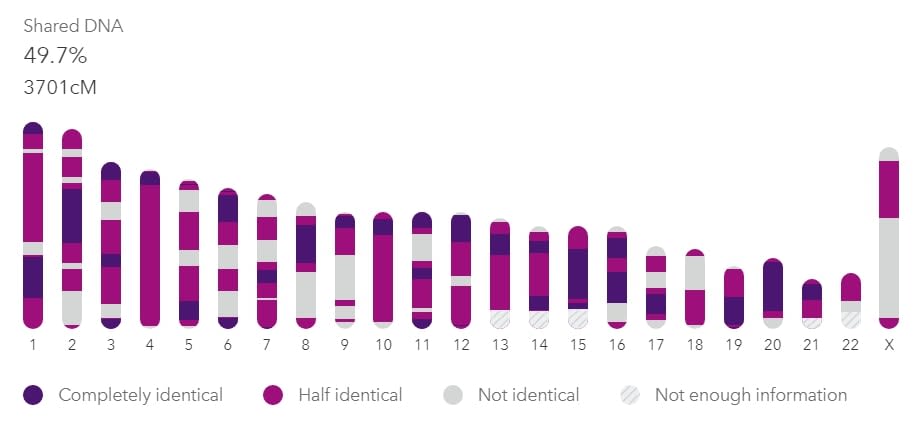
Comparison between full siblings showing how they share DNA on both copies of their chromosomes
23andMe’s “Advanced DNA Comparison” tool is a fantastic one-to-many Chromosome Browser which allows you to compare yourself or any of your matches (so long as they are open sharing or individually sharing with you) with up to 5 other matches at a time.
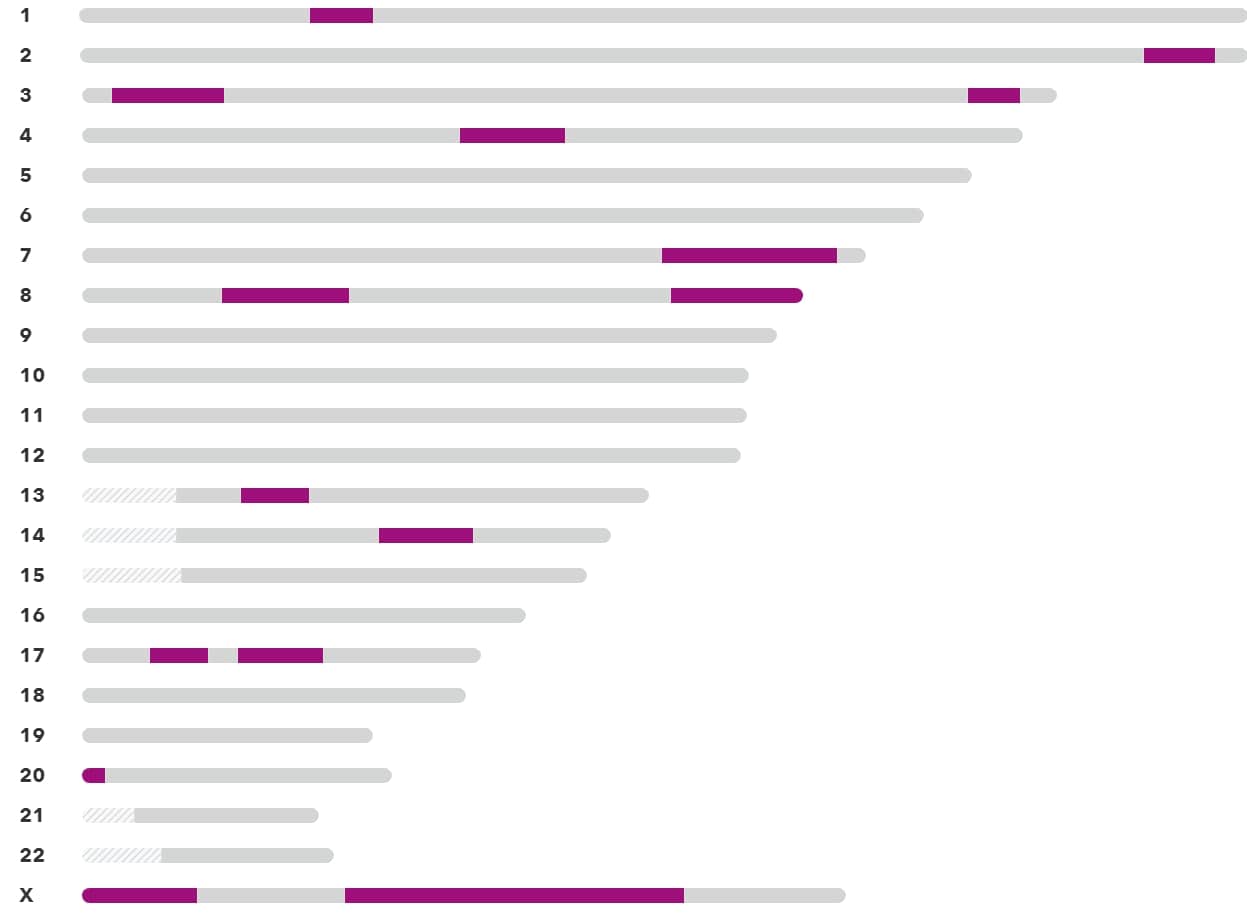
X-DNA (Chromosome 23) data is also included and exact start and end locations along with cM amounts are neatly displayed in a table underneath the visual. This is an excellent and comprehensive chromosome browser.
Ancestry does not provide segment data or a chromosome browser for privacy reasons. The lack of detailed segment data is one of the few negatives for Ancestry and if you want to use sites like DNA Painter for chromosome mapping you have to be aware it’s not possible to do this with Ancestry matches unless they upload their results to a site that provides segment data such as GEDMatch, FTDNA or MyHeritage.
Winner: 23andMe
Raw Data Transfers
Some major DNA testing companies allow you to upload results from competitor companies into their databases for free. You need to be aware that neither Ancestry nor 23andMe allow uploads to their sites so you have to take a direct test with both if you wish to get into their databases. Conversely you can download your raw data from both sites to upload to the sites that do accept transfers (MyHeritage, FTDNA and LivingDNA).
Winner: N/A
Health Insights
Although this article’s focus is on testing for genealogy purposes, it would be remiss not to mention health testing, as this has been a primary focus for 23andMe over many years and they are well-known for this. Their “Health + Ancestry” test includes the Ancestry aspects I have been assessing but also provides health predisposition reports, carrier status reports, wellness reports and trait reports.
Ancestry, up until this point, has never focused on health and wellness in the way 23andMe always have, but recently they added a new feature called AncestryTraits, which can be appended to their test for $20 and provides 26 personal trait reports such as eye color and bitter sensitivity. Then, on October 15th, they announced that they will be branching into the health testing arena with 2 new products named “AncestryHealth” and “Ancestry HealthPlus,” with the former being an entry level health test and the latter a more comprehensive one.
Given it’s not possible at this time to assess the Ancestry health offering, and 23andMe are the long-term market leader on this front, I have to recommend 23andMe if you are looking to gain health insights from one of these 2 tests.
Winner: 23andMe
Price
An AncestryDNA test will currently set you back $99 plus shipping ($9.95 for the first kit and $4.95 for each additional kit) while a 23andMe ancestry-only kit will also cost $99 plus shipping ($9.95). Both 23andMe’s “Ancestry + Health” test and Ancestry’s new “AncestryHealth” test currently cost $149. There are, however, regular sales at both sites and it’s worth looking out for those especially at DNA Day in April and Black Friday in November.
Winner: Draw
Conclusion
Overall Winner: AncestryDNA
For genealogy purposes, the most important consideration when choosing which company to DNA test with is database size; the larger the database the more chance you have of successfully finding matches that will aid you with your family history research. For this reason alone Ancestry, with a database of over 15 million testers in comparison to 23andMe’s still very large over 10 million database, is the winner in this particular battle. If you’re serious about using DNA testing for genealogy, though, it’s best to get into all of the major databases if you possibly can, as you don’t know where your best matches may choose to test. If you want to test somewhere with excellent tools in terms of segment data or if you are more interested in health insights, then 23andMe would be the winner for you, so assess your individual goals before making a decision. I have given this battle to Ancestry for genealogy purposes, but my top recommendation is always to test at both these powerhouse companies if you can!